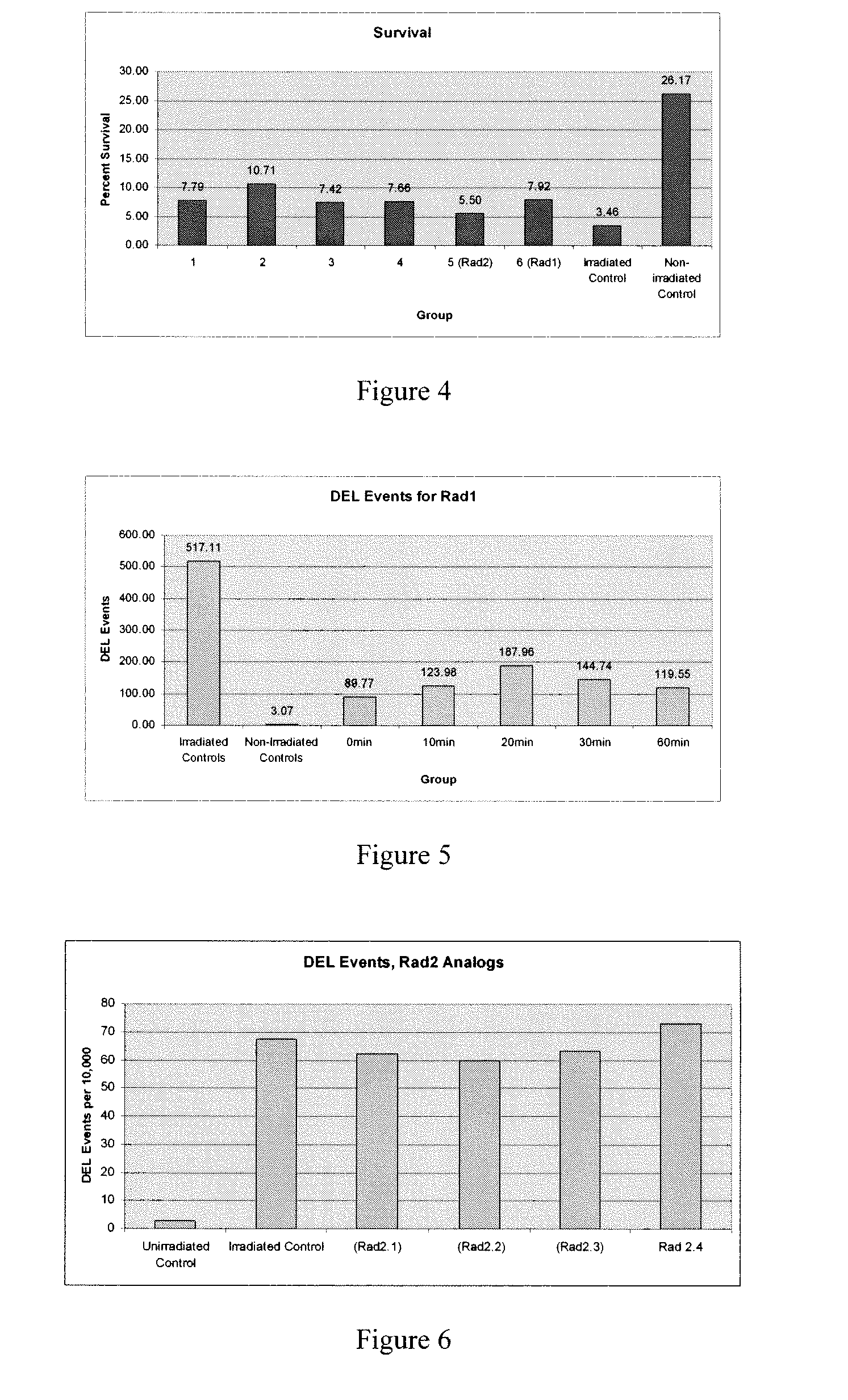Compounds and compositions for mitigating tissue damage and lethality
a technology of radiation-induced tissue damage and compounds, which is applied in the field of compounds for radiation-induced tissue damage and lethality, can solve the problems of genetic instability, large risk of theft or sabotage, and widespread radiation exposure scare, and achieve the effect of mitigating the ir damag
- Summary
- Abstract
- Description
- Claims
- Application Information
AI Technical Summary
Benefits of technology
Problems solved by technology
Method used
Image
Examples
example 1
Identification of Radiation Mitigators
[0187]Summary
[0188]We identified novel radiation mitigators from chemical libraries, which are inducers of DNA repair and are general anticancer agents since spontaneous cancers are due to the same mechanisms as radiation causes, namely oxidative damage and strand breaks.
[0189]All the hits from the yeast assay also protected human cells from radiation toxicity and prolonged the life of mice after radiation. Two of the chemicals turned out to be powerful radiation mitigators in that 67% of animals survived a lethal dose of radiation when the chemicals were given one hour and again 24 hours after radiation. The reason for this result can be several folds. One is that by screening against radiation induced genetic instability in addition to toxicity, it is more likely to select for chemicals that induce DNA repair which repairs damage leading to increased survival as well as reduced genetic instability. This is supported by our finding that nucleot...
example 2
Studies on Mitigation Efficacy of Yel1 and Yel1
[0218]The mitigation efficacy of Yel1 and Yel2 was tested within the actual therapeutic window: we have exposed radiation-sensitive C3H mice to 8Gy of ionizing radiation (LD100 / 30) and then treated them five times at 24,48,72,96, and 120 hrs with Yel1, Yel1 (75 mg / Kg) and PBS carrier. Yel2 has demonstrated a remarkable mitigation property: 100% survival (p-value=0.0209) at an LD100 / 30. Yel1 also showed efficacy (See FIG. 9). The same dose of 8Gy caused 100% death in the control in about 15 other experiments.
[0219]In addition, we have also replicated our original results with a 1.25 hr post irradiation treatment: both Yel1 and Yel2 show activity on this therapeutic schedule (Yel1 p-value=0.0455 and Yel2 p-value=0.0117) (See FIG. 10). This treatment protocol has application for first responders arriving at the site of the radiological incident and persons likely to receive high radiation doses through prolonged exposures.
examples 3-11
Studies on Mitigating Effects of Compounds on Radiation-Induced Conditions
[0220]Radiation protective compounds Yel001 (Formula IIA) and Yel002 (Formula IA) were subjected to various tests on their respective effects as radiation mitigator. The results are described below.
PUM
| Property | Measurement | Unit |
|---|---|---|
| time | aaaaa | aaaaa |
| composition | aaaaa | aaaaa |
| structure | aaaaa | aaaaa |
Abstract
Description
Claims
Application Information
 Login to View More
Login to View More - R&D
- Intellectual Property
- Life Sciences
- Materials
- Tech Scout
- Unparalleled Data Quality
- Higher Quality Content
- 60% Fewer Hallucinations
Browse by: Latest US Patents, China's latest patents, Technical Efficacy Thesaurus, Application Domain, Technology Topic, Popular Technical Reports.
© 2025 PatSnap. All rights reserved.Legal|Privacy policy|Modern Slavery Act Transparency Statement|Sitemap|About US| Contact US: help@patsnap.com



